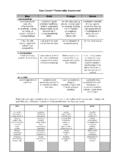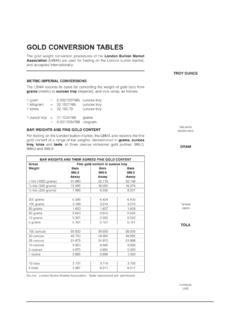Transcription of ACTIVATED CARBON IN GOLD RECOVERY - Kemix
1 1 | P a g e ACTIVATED CARBON IN gold RECOVERY John Rogans Marketing Director Kemix (Pty) Ltd 2 | P a g e Contents 1. INTRODUCTION .. 3 2. WHAT IS ACTIVATED CARBON ? .. 3 3. MANUFACTURING OF ACTIVATED CARBON .. 4 4. CHARACTERISTICS OF ACTIVATED CARBON .. 8 5. ADSORPTION .. 10 6. THE MECHANISM FOR gold ADSORPTION .. 13 7. FACTORS INFLUENCING gold ADSORPTION ONTO ACTIVATED CARBON .. 16 MIXING EFFICIENCY AND PULP DENSITY (IN CIP / CIL) .. 16 PARTICLE SIZE OF CARBON .. 17 ORGANIC POISONS .. 17 INORGANIC POISONS.
2 19 IONIC STRENGTH .. 22 pH AND CYANIDE CONCENTRATION .. 22 TEMPERATURE .. 22 gold TENOR AND CONTACT TIME .. 23 ACTIVATED CARBON TYPE .. 23 8. DESORPTION (ELUTION) .. 26 FACTORS INFLUENCING 27 TYPES OF ELUTION .. 27 9. CARBON IN PULP / CARBON IN LEACH .. 30 SCREENING .. 31 APSORPTION / ELUTION / ACIDWASHING / REGENERATION .. 33 ACID WASHING .. 33 THERMAL REGENERATION .. 33 10. THE IMPORTANCE OF CIRCUIT AND ACTIVITY PROFILES .. 35 ACTIVATED CARBON TYPE .. 37 ACTIVATED CARBON CONDITIONS .. 37 PLANT VARIABILITY AND BALANCING.
3 39 11. SAMPLING, SAMPLE PREPERATION AND SAMPLE CONTAMINATION .. 40 12. CARBON IN-LEACH (CIL) CARBON -IN-PULP (CIP), CAROUSEL CIP AND PROCESS SELECTION .. 41 CARBON -IN-PULP (CIP) .. 41 CARBON -IN LEACH .. 42 PUMPCELL 43 CHOICE OF ADSORPTION CIRCUIT .. 45 3 | P a g e 1. INTRODUCTION This article serves to discuss the fundamental aspects of gold RECOVERY utilizing the CARBON -in-Pulp or CARBON -in-Leach processes. The purpose is to describe in simple terms what ACTIVATED CARBON is all about and how it adsorbs gold . The understanding of the mechanism of gold adsorption is important because the CIP/CIL processes work as a result of the gold adsorption mechanism, which is a chemical occurrence.
4 Factors that affect the adsorption of gold are discussed. Finally, performance monitoring methods that help control the operation of the CIP/CIL process are discussed. 2. WHAT IS ACTIVATED CARBON ? " ACTIVATED CARBON " is a generic term for a family of highly porous carbonaceous materials that cannot be defined by a structural formula, or by chemical analysis. In other words, a piece of CARBON with millions of tiny interlocking holes (called pores) is called ACTIVATED CARBON . Under a microscope, ACTIVATED CARBON looks like a sponge. The millions of tiny interlocking holes occupy space within the CARBON and thus ACTIVATED CARBON has a very high internal surface area.
5 Typical ACTIVATED carbons used in the CARBON -in-Pulp (CIP) and CARBON -in-Leach (CIL) processes have surface areas of about 1000 m /g one gram of ACTIVATED CARBON (the amount of which will occupy the same space as the end of a person's thumb) has the same surface area as two football fields. The high surface area is contained in the millions of pores of varying sizes, these being defined by the following groups: Macropores (500 to 2000 in diameter) these are the large pores that run from the surface of the ACTIVATED CARBON into the interior. The macropores allow for the rapid movement of adsorbates (species that will be adsorbed by the CARBON , gold ) into the ACTIVATED CARBON granules.
6 Mesopores (100 to 500 ) these are the pores that branch off the macropores that serve to allow the adsorbates to leave the macropores Micropores (8 to 100 ) which are of the right size to allow the adsorbates to be strongly adsorbed by ACTIVATED CARBON . These pores generally occupy 95 % of the total internal surface area of ACTIVATED CARBON . It is within the micropores that adsorption takes place, however the meso and macropores are important because they facilitate the rapid transport of the adsorbates into the ACTIVATED CARBON . * Note is an angstrom.
7 One angstrom is cm or 10-9 cm. 4 | P a g e ACTIVATED CARBON is essentially CARBON , it is inert, and so it carries no charge (unlike Na + Cl - ; salt). Since ACTIVATED CARBON carries no charge, its internal surface area is also neutral, therefore ACTIVATED CARBON will adsorb only neutral species. As a result ACTIVATED CARBON will adsorb any neutral species from water, industrial solutions and from gasses, leaving behind the charged species such as Na + and Cl - . The applications of ACTIVATED CARBON are wide spread, examples of some are as follows: Removal of organic species from industrial effluents.
8 Removal of organic contaminants (and chloride from portable water). RECOVERY of precious metals like gold . Removal of contaminants in gas, gas masks. Medicinal removal of certain species in human digestive system. As a carrier for impregnates. 3. MANUFACTURING OF ACTIVATED CARBON ACTIVATED CARBON is manufactured form carbonaceous raw materials. Examples are: Coal: Peat, Lignite, Bituminous coal, Anthracite. Nut shells: Coconut, Macadamia. Pips: Apricot, Peach, Olive. Wood. Cellulose. Heavy oil. Bones. The requirement is that raw materials are available in sufficient quantities to support commercial production.
9 Typical cabon content of some raw materials are: Material CARBON Content (%) Wood 40 Coconut shell 40 Lignite 60 Bituminous coal 75 Anthracite 90 There are two methods in which ACTIVATED CARBON is produced: 1. Chemical In which the raw material is mixed with acids such as Phosphoric or Sulphuric acid, dried then heated up to 650 C. In the Calcination step the impregnated chemicals dehydrate the raw material resulting in charring and creation of a porous structure. Chemical activation is used most often in manufacturing ACTIVATED CARBON from wood.
10 5 | P a g e 2. Physical (thermal) In which the raw material is firstly charred in the carbonization step. The char is then heated at elevated temperatures in the presence of steam to create ACTIVATED CARBON . In gold RECOVERY applications, ACTIVATED CARBON manufactured by Thermal activation is used. This process will be discussed in more detail. There are a number of steps in the production of ACTIVATED CARBON : Preparation of raw material The raw material may be collected, cut and cleaned as the preparation step. This applies to nut shells, pips and wood.







